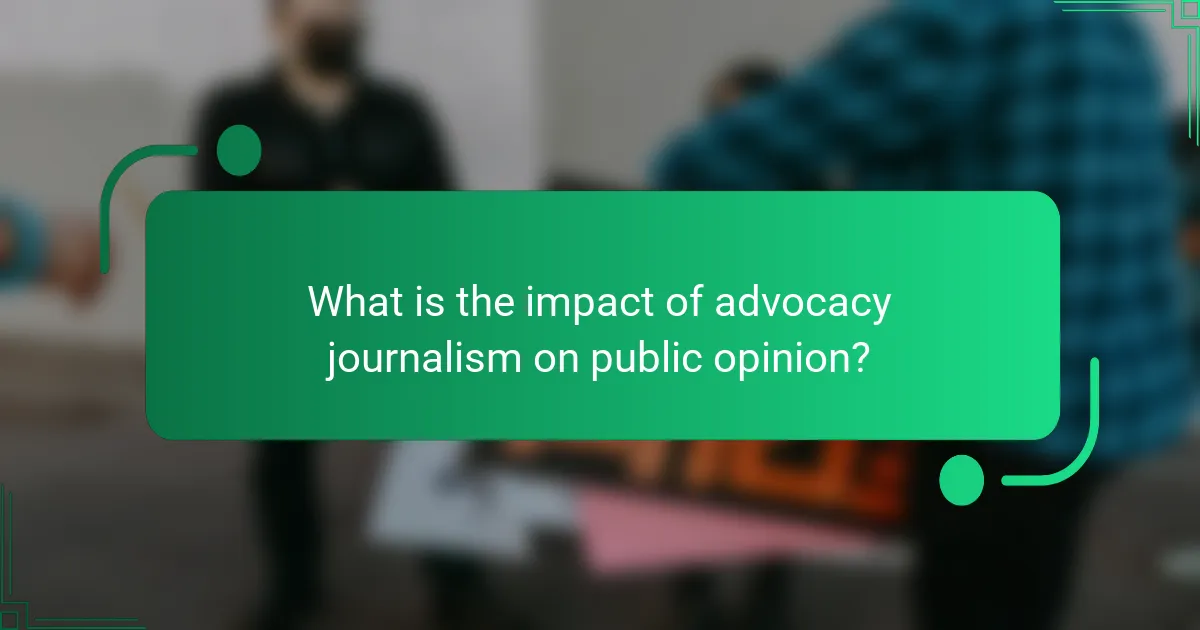Advocacy journalism harnesses the power of interactive content to deepen audience engagement and connection with critical social issues. By utilizing multimedia storytelling, polls, and social media, journalists can create participatory experiences that invite audience involvement and feedback. This approach not only fosters a sense of community but also drives impactful storytelling that can shape public opinion and influence policy decisions.

How can advocacy journalism use interactive content?
Advocacy journalism can leverage interactive content to enhance audience engagement and foster a deeper connection with issues. By incorporating elements like multimedia storytelling, polls, and social media, journalists can create a more participatory experience that encourages audience involvement and feedback.
Engagement through multimedia storytelling
Multimedia storytelling combines text, images, video, and audio to create a rich narrative experience. This approach captivates audiences by appealing to different senses and learning styles, making complex issues more relatable. For example, a documentary-style video paired with infographics can illustrate the impact of a social issue more effectively than text alone.
When creating multimedia content, consider the flow and integration of each element. Ensure that visuals and audio complement the narrative, enhancing understanding rather than distracting from it. Tools like Adobe Spark or Canva can help create engaging visuals without requiring extensive design skills.
Utilizing polls and surveys for audience input
Polls and surveys are effective tools for gathering audience opinions and insights. By asking targeted questions related to advocacy topics, journalists can gauge public sentiment and tailor content to address audience concerns. For instance, a survey on climate change can reveal which aspects resonate most with readers, guiding future articles.
To maximize participation, keep surveys concise and user-friendly. Platforms like SurveyMonkey or Google Forms allow for easy distribution and analysis. Offering incentives, such as a chance to win a gift card, can also boost response rates.
Incorporating social media for real-time feedback
Social media platforms provide a dynamic space for real-time audience interaction and feedback. Journalists can use platforms like Twitter or Instagram to share updates, solicit opinions, and engage in discussions about advocacy topics. This immediate feedback loop helps journalists understand audience reactions and adjust their messaging accordingly.
To effectively use social media, establish a consistent posting schedule and actively respond to comments and messages. Engaging with followers can foster a sense of community and encourage more in-depth conversations about important issues. Additionally, using relevant hashtags can increase visibility and reach a broader audience.

What engagement techniques enhance advocacy journalism?
Engagement techniques that enhance advocacy journalism focus on fostering active participation and collaboration among audiences. These methods create a sense of community and shared purpose, driving deeper connections and more impactful storytelling.
Community-driven content creation
Community-driven content creation involves inviting audience members to contribute their voices and perspectives. This approach not only enriches the narrative but also empowers individuals, making them feel invested in the advocacy cause.
To implement this, consider setting up platforms where community members can submit articles, videos, or artwork related to the advocacy topic. This could be a dedicated section on your website or social media channels that highlights user contributions.
Collaborative storytelling with local activists
Collaborative storytelling with local activists brings authentic voices to the forefront of advocacy journalism. By partnering with those directly affected by the issues, journalists can present more nuanced and compelling narratives.
Engage local activists by co-creating content that reflects their experiences and insights. This could involve interviews, joint articles, or multimedia projects that showcase their work and the challenges they face, thereby increasing visibility and support for the cause.
Leveraging user-generated content
Leveraging user-generated content (UGC) allows advocacy journalism to tap into the creativity and insights of its audience. UGC can take various forms, including social media posts, videos, and testimonials that highlight personal stories related to the advocacy issue.
Encourage your audience to share their experiences by creating specific hashtags or campaigns. This not only broadens the reach of your message but also fosters a sense of community among supporters, enhancing overall engagement with the advocacy effort.

What is the impact of advocacy journalism on public opinion?
Advocacy journalism significantly shapes public opinion by highlighting social issues and influencing perceptions. It serves as a catalyst for awareness and engagement, often leading to tangible changes in community attitudes and policy decisions.
Shaping narratives around social issues
Advocacy journalism plays a crucial role in framing narratives that resonate with the public. By focusing on underrepresented voices and issues, it can shift the conversation and bring attention to critical topics that may otherwise be ignored.
For example, stories that highlight the struggles of marginalized communities can foster empathy and understanding, encouraging readers to engage with these issues more deeply. This narrative shaping is essential for driving social change and mobilizing public support.
Influencing policy changes through awareness
By raising awareness about specific issues, advocacy journalism can directly influence policy changes. Journalists often investigate and report on injustices, prompting public discourse that can lead to legislative action.
For instance, coverage of environmental concerns can spur local governments to implement stricter regulations or promote sustainability initiatives. Effective advocacy journalism not only informs the public but also holds policymakers accountable for their actions.
Building trust within communities
Advocacy journalism fosters trust by providing reliable information and amplifying community voices. When journalists engage with local issues and report authentically, they build credibility and rapport with their audience.
Community-focused reporting can lead to stronger relationships between journalists and residents, encouraging more people to share their stories and participate in civic engagement. This trust is vital for creating a more informed and active citizenry.

What are the prerequisites for effective advocacy journalism?
Effective advocacy journalism requires a clear understanding of the issues at hand, a well-defined target audience, and strong partnerships with local organizations. These elements help ensure that the journalism produced resonates with readers and drives meaningful engagement.
Understanding the target audience
Identifying and understanding the target audience is crucial for advocacy journalism. This involves researching demographics, interests, and the specific issues that matter to them. Tailoring content to meet the needs and preferences of the audience can significantly enhance engagement and impact.
Consider creating audience personas to visualize different segments. For example, a persona might represent young activists interested in environmental issues, while another could focus on older community members concerned about local governance. This approach helps in crafting relevant messages that resonate with each group.
Establishing partnerships with local organizations
Building partnerships with local organizations can amplify the reach and credibility of advocacy journalism. Collaborating with nonprofits, community groups, or educational institutions can provide valuable insights and resources, enhancing the quality of the journalism produced.
When seeking partnerships, focus on organizations that align with your advocacy goals. For instance, if covering health issues, partnering with local health clinics can provide access to expert opinions and firsthand stories. Additionally, these partnerships can facilitate events or campaigns that further engage the community.

How does advocacy journalism compare to traditional journalism?
Advocacy journalism actively promotes a specific cause or viewpoint, contrasting with traditional journalism’s emphasis on impartiality and neutrality. While both aim to inform the public, advocacy journalism seeks to influence social change through storytelling and engagement.
Focus on social justice versus neutrality
Advocacy journalism prioritizes social justice issues, often highlighting marginalized voices and systemic inequalities. This approach contrasts with traditional journalism, which strives to present multiple perspectives without bias, aiming for a balanced narrative.
For example, an advocacy journalist might cover a community’s struggle against environmental degradation, emphasizing the need for policy change. In contrast, a traditional journalist would report on the same issue by presenting views from both the community and the corporations involved, without taking a stance.
Engagement strategies differ significantly
Engagement strategies in advocacy journalism often involve interactive content, such as social media campaigns, petitions, and community events. These methods aim to mobilize audiences and encourage active participation in social causes.
Traditional journalism, however, typically focuses on delivering news through articles, broadcasts, and reports, with less emphasis on audience interaction. While both forms can utilize digital platforms, advocacy journalism leans heavily on fostering dialogue and community involvement.

What tools can enhance advocacy journalism efforts?
Advocacy journalism can be significantly enhanced through various tools that facilitate storytelling, engagement, and measurement. Utilizing the right platforms and analytics tools can help journalists effectively convey their messages and assess their impact on audiences.
Using platforms like Medium for storytelling
Medium is a powerful platform for advocacy journalism, allowing writers to reach diverse audiences through engaging narratives. Its user-friendly interface and built-in community features enable journalists to publish articles that can be easily shared and discussed.
When using Medium, consider focusing on compelling visuals and personal stories to draw readers in. Incorporating multimedia elements such as images, videos, and infographics can enhance the storytelling experience and make complex issues more relatable.
Analytics tools for measuring engagement
Analytics tools are essential for measuring audience engagement in advocacy journalism. Platforms like Google Analytics and social media insights provide valuable data on how readers interact with content, including page views, time spent on articles, and social shares.
To effectively use analytics, set clear goals for your content, such as increasing shares or comments. Regularly review the data to identify trends and adjust your strategies accordingly. Avoid focusing solely on vanity metrics; instead, prioritize meaningful interactions that indicate genuine engagement with your advocacy message.
